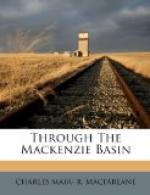A much more extensive open country, however, is the Grand Prairie, to the south-west of the Crossing, which connects with the Spirit River country, and is drained by the Smoky River and its branches, and by its tributary, the Wapiti. There is no dispute as to whether this should or should not be called a prairie country. As a matter of fact, it is an extensive district suitable for immediate cultivation, and containing, as well, valuable timber for lumber, fencing and building.
The first inquiry the intending immigrant makes is about frost. At the Dunvegan and St. Augustine Mission farms, on the river bank above the Landing, Father Busson told me that White Russian and Red Fyfe wheat had been raised since 1881, and during all these years it had never been seriously injured, whilst the yield has reached as high as thirty-five bushels to the acre. Seeding began about the middle of April, and harvesting about the middle of August. He was of opinion that along the rim of the upper prairie level wheat would ripen, but farther back he thought it unsafe, and so no doubt it is for the present. Mr. Brick’s fine farm, opposite the Six Islands, and other farms also, were a success, but, of course, all these were along the river. With regard to the upper level, I heard opinions adverse to Father Busson’s, though, like his, conjectural. The inconsiderable height above the sea (Lefroy, I think, puts the upper level at about 1,600 feet), the prolonged sunlight, the whole night being penetrated with it though the sun has set, together with good methods of farming, will no doubt get rid of frost, which strikes here just as it has in every new settlement in Manitoba, and in fact throughout a great portion of the continent.
There were complaints, however, of a worse enemy than frost, namely, drought, which we were told was a characteristic feature of those magnificent prairies to the north. The wiry grass is very short there, something like the Milk River grass in Southern Alberta, and hay is scarce. This drawback will doubtless be got over hereafter by dry farming, or better still by irrigation, should the lakes to the north prove to be available.
I have pointed out disadvantages which in all likelihood will disappear with time and settlement by good farmers. It is a region, I believe, predestined to agriculture; but, in some localities, the rainfall, as has been said, is rather scant for good husbandry, and, therefore, farming to the north of the river, on the upper level, is not as yet an assured success. To the south better conditions prevail, and thither no doubt the stream of immigration will first trend.




